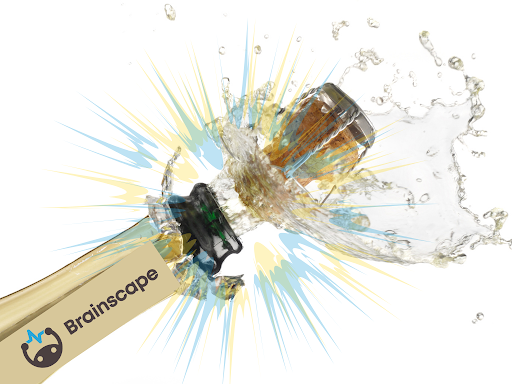From birthdays to break-ups and weddings to Wednesdays, bubbly wine is a total joy on (and tonic for) any occasion. But when all of your hard work and studying hinges on you taking an exam on the world’s generous repertoire of sparkling wines AND correctly assessing a flight of them, stone cold blind, things can go from being a joy to a job.
Well, fear not, intrepid wine nerd, for the guide you now hold in your virtual hands (1) gives you the tools to help you study the required content more efficiently and (2) equips you with the right strategies (and tricks) for scoring maximum points on the practical tasting portion of the exam.
Who are we and what the heck do we know about passing the WSET* Diploma D4?
Well, we’re Brainscape, the world’s smartest study app, and we’ve plundered the mental coffers of Master Sommelier candidate and Certified Wine Educator Sarah Looper—a WSET Diploma candidate who has passed the Sparkling Wine unit—for her best advice on preparing for both the written and tasting exam. (We also wrote a guide for D1 Wine Production, so check that out if you haven't yet cleared that hurdle.)
Together, we’ve also distilled the entire WSET diploma sparkling wines (D4) curriculum down into a collection of 13 neatly organized decks of 640+ flashcards. And these, you can use to drill yourself (using our intelligent spaced repetition algorithm) on the key facts you need to know about the principal sparkling wines of the world!
Explore Brainscape’s certified WSET 4 D4 Sparkling Wine flashcards here.
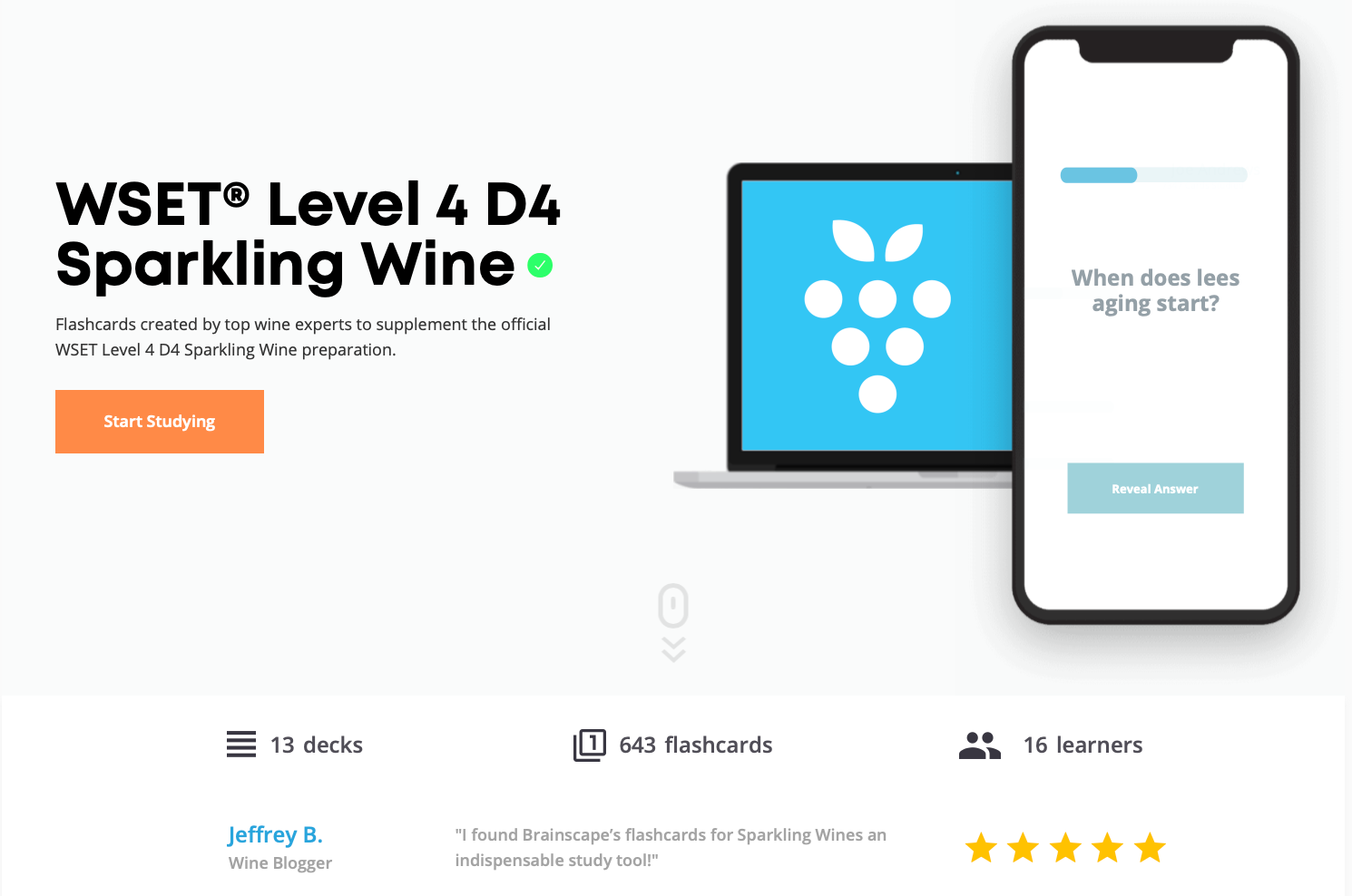
We’ve also compiled a comprehensive collection of study guides and digital flashcards for these other WSET Diploma exams and upgrading to Pro gets you access to all of them for the same price:
Armed with these flashcards and Sarah’s advice, you’ll have the tools and strategies you need to do exceedingly well on the WSET Diploma D4!
[The WSET or Wine & Spirits Education Trust provides globally recognized education and qualifications in wines, spirits, and sake, for professionals and enthusiasts. Our flashcards are a complement to their full course and textbooks.]
Let’s get started!
Tips for studying sparkling wine for WSET 4 D4
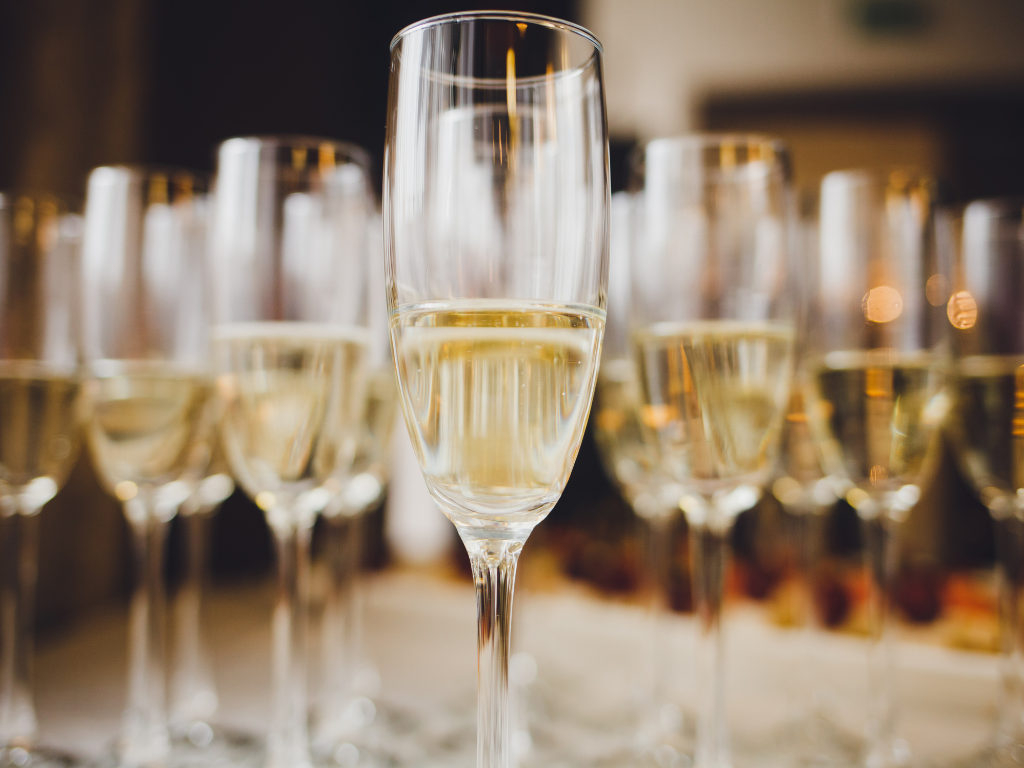
The biggest challenge in taking the WSET Diploma on Sparkling Wines (D4)—or any of its other units for that matter—is the staggering amount of information you need to remember about the different wine styles, from Champagne, Crémant, Cava, and Cap Classique to sparkling wines from California, Oregon, Washington State, South Australia, Victoria, Tasmania, South Eastern Australia, Chile, Argentina, England, Wales...GASP!
So, our advice is:
- Start studying early, with plenty of time to beat the facts into your brain.
- Refresh the content covered in your D1 Wine Production module (check out our certified WSET 4 D1 flashcards here) because that provides the crucial foundational knowledge you'll need.
- Stick to the materials given to you by the WSET (every question they ask will come from the textbook).
- Work according to a detailed, well-laid-out study plan.
- Make use of plenty of visual tools, like regional maps, to help you remember things.
- Practice questions and exams as early on in your prep as possible so that you understand how the information will be tested.
- Review the content frequently so that nothing fades from memory.
- Don’t just memorize the facts: understand them and how they relate to the greater tapestry that is terroir, viticulture, winemaking, etc.
- Don’t avoid your weaknesses: focus on them!
- Don’t assume that you won’t get asked about wines from the “lesser-known” wine regions! These frequently show up in the exam.
[If you’re as geeky about wine as we are, join our Wine Community in Discord where we share all of our coolest facts, food pairing tips, wine life hacks, trivia, and so much more. Here, you can chat to other wine nerds from around the world and just generally live your best wine life!]
Facts you need to know well for the WSET 4 D4 exam
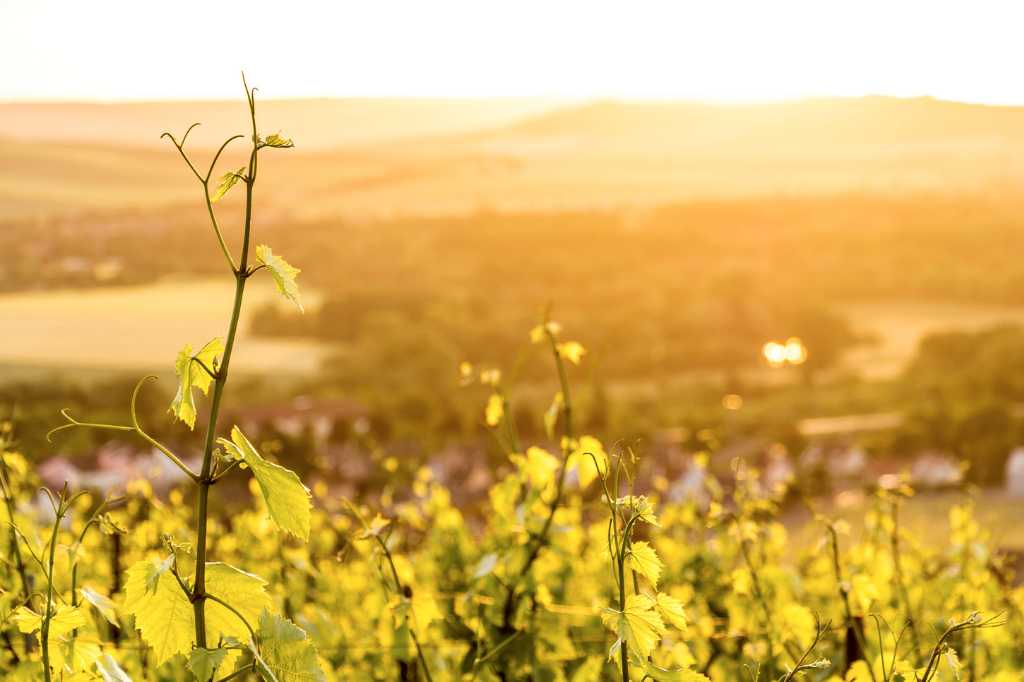
- Know all of your Champagne terms, even the Frenchiest ones. Seriously, you’ll feel like you’re fluent in the “language of love” by the time you’re done, but it is essential to know what dosage, assemblage, degorgement, battenage, etc. mean.
- Know the different styles and vintages of Champagne (Blanc de Blancs, Blanc de Noirs, Rosé, NV, Vintage, Grand Cru, Premier Cru, Prestige Cuvée, and Late Release). Also, know how they’re made and why a winemaker might choose to make a particular style of wine in a particular year.
- Know the major goalposts of the different styles of sparkling wines: What region/s are known for producing them? What grapes are used? What is the terroir like? What is the precise method used to make these wines? And what are their diagnostic flavors and aromas? You should be able to describe each style of bubbly so well that the examiner practically feels those bubbles caressing their cheeks!
- Know your dosage levels and the exact corresponding numbers for grams of sugar per liter, for example: Brut = 0 to 12 grams of sugar per liter; Sec = 17 to 32, etc; Demi-sec = 32 to 50; Doux = more than 50, and so on.
- Know how fermentation (and fermentation temperature and method) is harnessed to craft each style of sparkling wine. Is it tank or barrel fermented? Is the first fermentation warmer or cooler? Why? How does this influence flavor, body, aroma, and bubbles?
- Know about leesation, why wines are aged on the lees (adds depth and complexity), and the impacts it has upon the body, nose, and flavors. More than just knowing this theory, you should be able to distinguish this on the wines you’re given to blind taste.
- Know about the suitable alternatives to Champagne, such as Crémant, Cava, and Cap Classique and all the information on style, terroir, grapes, etc. discussed above.
Use flashcards to memorize the facts
Yes, we know. That’s A LOT of content to remember. But we have the perfect study tool to help you do that efficiently: our certified WSET Diploma D4 Sparkling Wine flashcards.
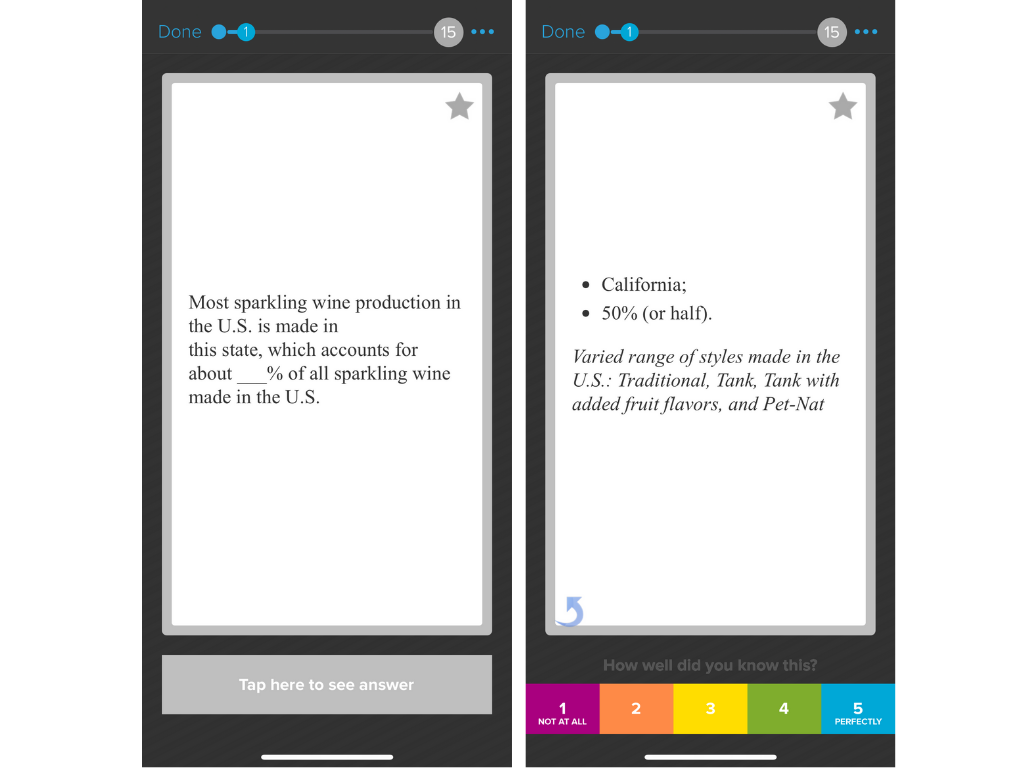
As previously explained, Brainscape has broken down the WSET 4 D4’s entire sparkling wine curriculum into a collection of flashcards, which are an excellent supplemental study tool to use in conjunction with your textbooks and other reading materials.
What makes our flashcards so incredibly effective is that they leverage spaced repetition and other cognitive learning principles like active recall and metacognition to help you learn twice as efficiently as traditional study techniques.
And forget games and fancy bells and whistles. We understand that you’re serious about learning so you don’t need to “trick yourself” into studying. As such, our app is based purely on proven cognitive science, which is exactly the kind of firepower you need when you’re trying to remember a Mount Olympus-sized amount of information on the world’s sparkling wines.
So, get your paws on Brainscape’s WSET Diploma on Sparkling Wine (D4) flashcards to relentlessly drill yourself on the most important facts using spaced repetition.
We also have a comprehensive collection of flashcards for:
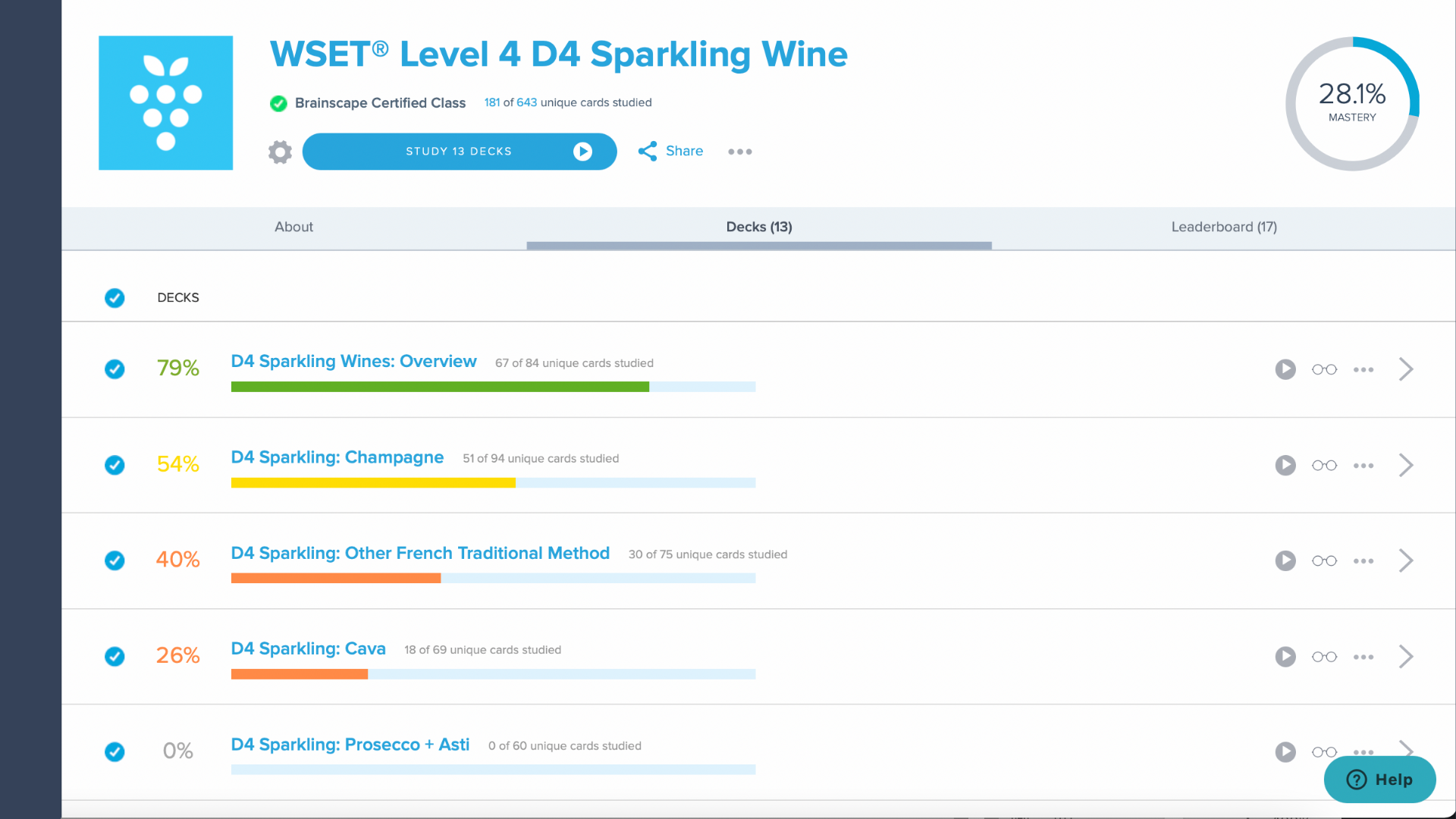
By the way, we also have wine study guides (like this one) for these modules so make sure you check ‘em out ahead of your other exams, too:
- How to pass the WSET 4 D1 exam on Wine Production
- How to pass the WSET Diploma D2 exam on the Business of Wine
- How to pass the WSET Diploma D3 exam on the Wines of the World
- How to pass the WSET Diploma D5 exam on Fortified Wines
Tips for blind tasting sparkling wine for WSET Diploma D4
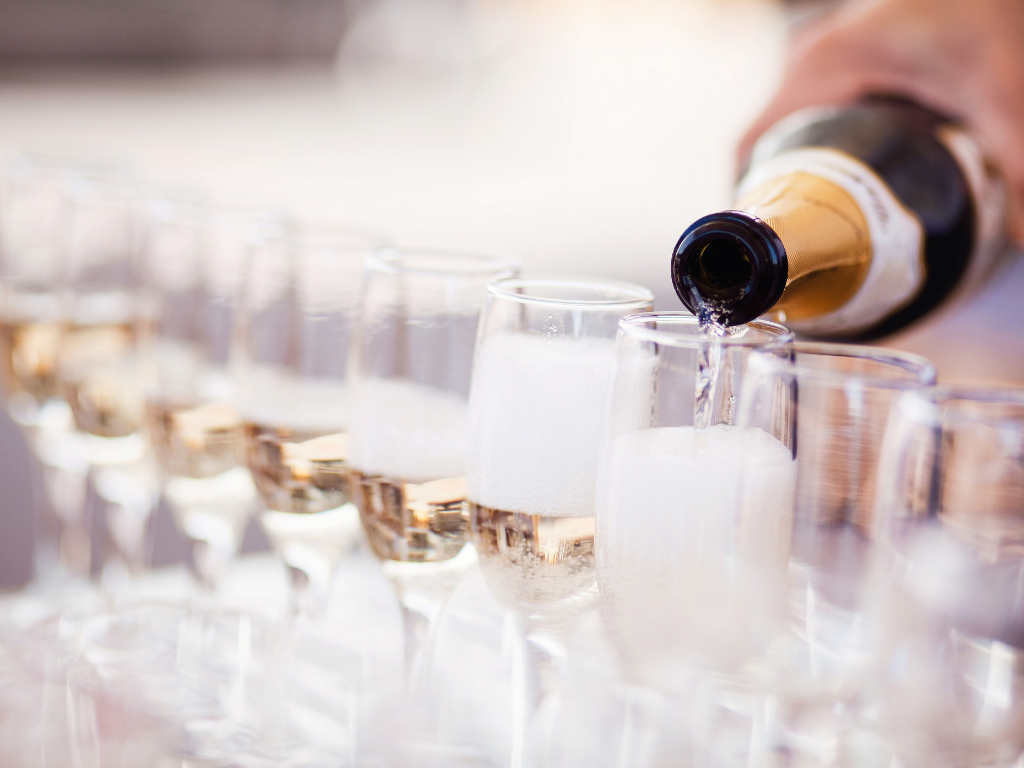
So, you’ve wrapped up the written portion of the exam. Time to relax and drink some bubbles! Haha! That’s funny … tell another one!
Here’s the thing about the practical portion of the WSET 4 D4: it is just as theory-heavy as the written portion.
To do well, you have to demonstrate a deep knowledge of the world’s sparkling wines, their key characteristics, and how terroir, viticulture, and winemaking methods are exhibited by color, flavor, aroma, mousse, acidity, ABV, and more. Practical experience will teach you how to make your observations. The theory will teach you the “why” and, therefore, what the wine is most likely to be.
Remember, you can make an incorrect identification, but if your tasting notes are detailed with accurate explanations and observations, you will pass with flying colors! To help you do this, here are our wine panel’s best tips, which we’ve taken care to present in a progressive tasting strategy, which you can employ during the WSET Diploma D4 practical exam …
Tip 1: Watch the examiner pour the wine
Don’t wait until the wine is in front of you before you start your detective work. Observe closely as the examiner pours the wine: notice how the bubbles behave, both as the wine tumbles into the glass and as it seethes afterward. Write down what you observe.
There are some powerful clues right here at the outset of your exam. Prosecco, for example, gives itself right away with its flash-in-the-pan explosion of froth. (Prosecco is like the “woo” girl at a party: the first to vigorously bubble up with energy.) Champagne, as you well know, has much finer bubbles and effervesces in a more restrained and refined manner.
Pssst. Check out Brainscape’s certified WSET 4 D4 decks on Champagne and Prosecco!
Tip 2: Take detailed notes on color and initial nose, right away
Before taking a single sip, take as detailed notes as possible on the color and initial nose of the wine right away, while it’s cold and fresh out of the bottle. The bouquet will likely change as the wine comes into contact with oxygen and warms up to room temperature, so you’ll want to capture the “before and after” of that evolution.
Tip 3: Pay special attention to the nose
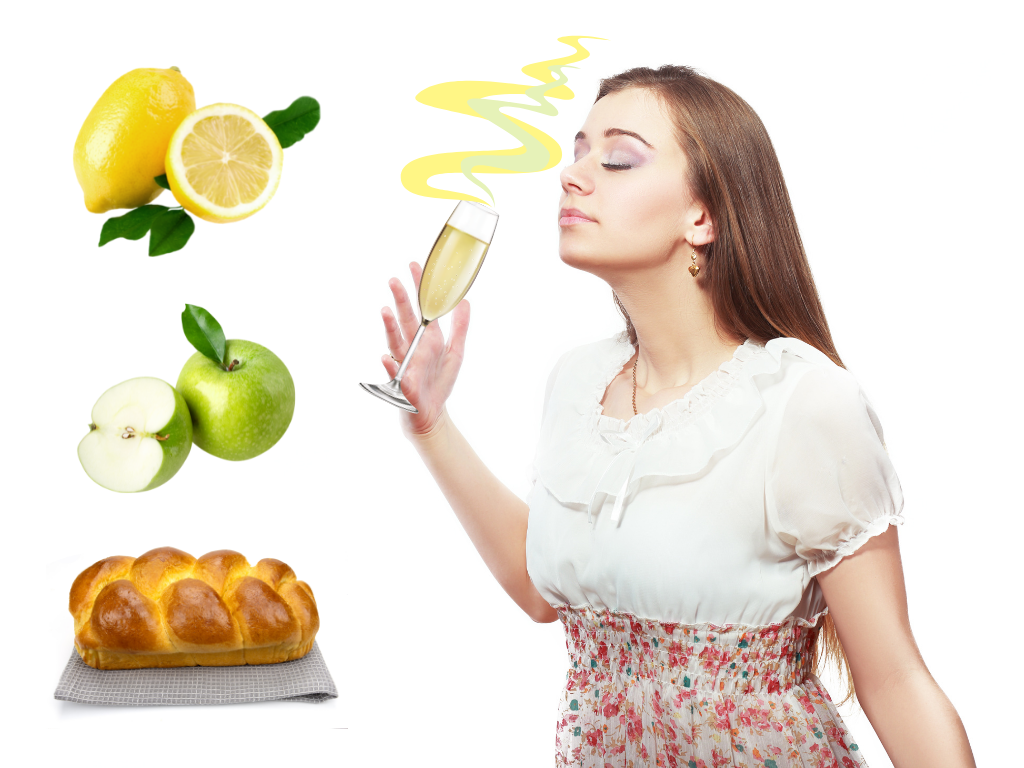
The nose of a sparkling wine is a veritable treasure trove of information. And the clues it yields can often lead you to the correct identification. Here are some things to consider:
- Are there dominant floral notes? The wine might be a Prosecco, Sekt, or Asti.
- Are there autolytic/leesy notes? Traditional method sparkling wines (Champagne, Crémant, Cava, new world sparkling wines) that are aged for extended periods on the lees will have pronounced yeasty aromas like bread, cheese, or buttermilk or even sometimes sweet, nutty aroma.
- Can you detect a rubber-like aroma? Some Cavas are guilty of this, exhibiting a waxy floral aroma that can lean towards kerosene, petrol, and rubber. They also always have an earthy component, rather than being clean-fruited, autolysis aside. (Check out Brainscape’s certified WSET Level 4 flashcards on Cava.)
- Are there notes of diesel, gunmetal, or railway yard? Riesling alert!
- Is there a distinct minerality to the nose? Alors, c’est peut être Champagne!
- Are there tropical fruit notes? Could be bubbly from California or Australia.
- What about wet wool or lanolin-like smell? Chenin Blanc!
These are not absolute rules but they can serve as helpful guidelines to consider as you whiff your way through your flight of bubbly wines.
Tip 4: Don’t ID the wine yet
At this point, you’re just gathering information so unless you have a powerful instinct or impression, try not to stress about identifying what the wine is. This might distract you from objectively assessing the evidence in front of you.
Tip 5: Taste the wines in order of heft
Now that you’ve sniffed each wine, order them according to the strength of their aromas, from the lightest to the most powerful. This will prevent a more powerful wine’s aromas and flavors from eclipsing the next wine you sample in the series. And if you do have any red sparkling wines, definitely leave them for last.
Then, go ahead and taste, leaving enough for a follow-up tasting later on.
Tip 6: Write down EVERY. THING. you can think of
All of your theory comes into play when you do your tasting section so FLAUNT YOUR KNOWLEDGE! (In fact, it’s very possible to turn around a mediocre performance on the written test with outstanding tasting notes in the practical exam.)
So write down everything that comes to your head/senses when you explore the WSET 4 D4’s sparkling wines. Detect citrus? Write down every relevant tasting note that applies: lemon, lemon rind, Meyer lemon, lemon curd, lemon meringue, lime, lime zest, lime jelly, lime freaking stone. Detect apple? Write down: green apple, Granny Smith apple, yellow apple, apple skin, apple sauce, bruised apple, Adam’s apple.
Okay, not that last one. But you get the point, right?
Apply this approach to every observation you make, from the bouquet to the palate; the bubbles to the balance, and everything between. Be relevant but be exhaustive.
Tip 7: Use acidity as an important clue
The acidity of the bubbly is a really important distinguishing point so intimately knowing the typical acidities of the various sparkling wines (and what it feels like on the palate) will really give you the upper hand.
Champagne, for example, usually delivers a high ringing acidity that lingers at the back of the throat with Blanc De Blanc Champagne exhibiting a piercing minerality on the palate, too. Cava, on the other hand, is riper than Champagne with softer acids and a more rounded body.
Here are the cheat codes to acidity:
- Low acidity, fuller body with tropical/stone fruit = think warmer regions
- High acidity, light to medium body with citrus/green/apple/pear fruit = cooler regions.
Tip 8: Sniff and taste the wines again
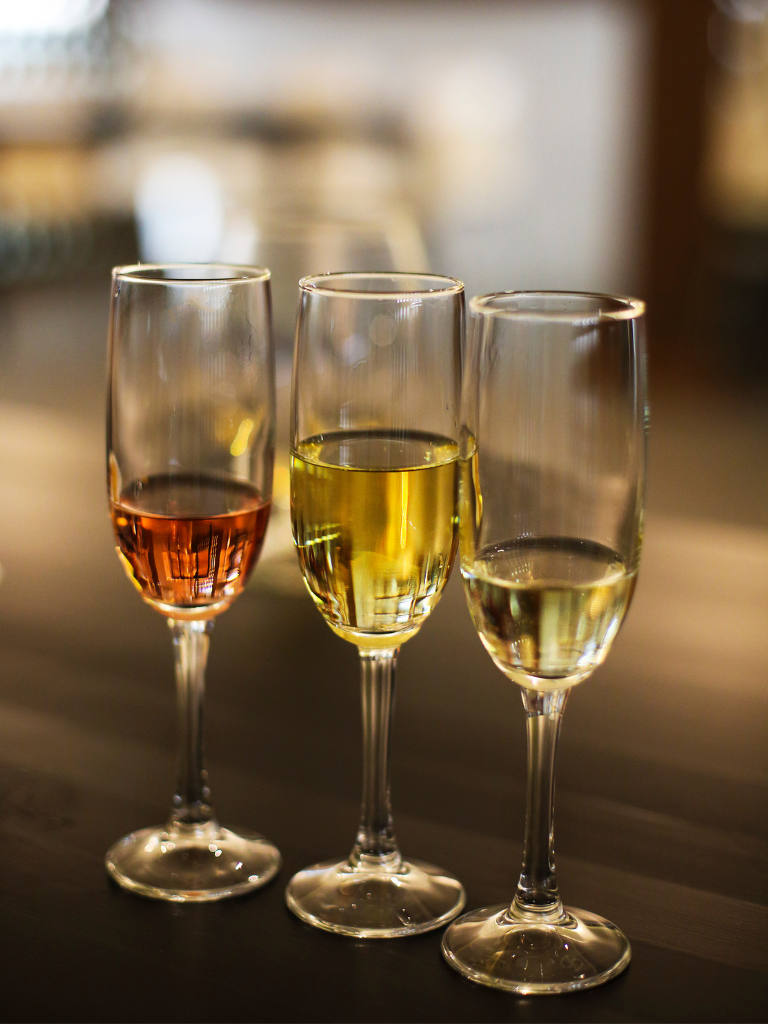
Smell the wines again, from the least aromatic / lightest wine to the heaviest. Are there any new notes that have shown up? The aromas can become heightened as the wine warms up to room temperature, or it can even release new aromas you hadn’t perceived before.
Also, taste the wines again. Did you miss anything? Is your palate, which has now been influenced by the heavier wines, picking up on anything new? Write everything down!
Tip 9: Make your best-educated guess
Consider all of the evidence you’ve gathered and, using your extensive theoretical knowledge, make your best-educated guess on what the WSET 4 D4 sparkling wines could be. It doesn’t matter if you get the ID wrong; if your tasting notes are comprehensive, accurate, and perceptive and demonstrate your knowledge to the examiner, you’ll ace the exam.
Tip 10: Does the mousse agree with your ID?
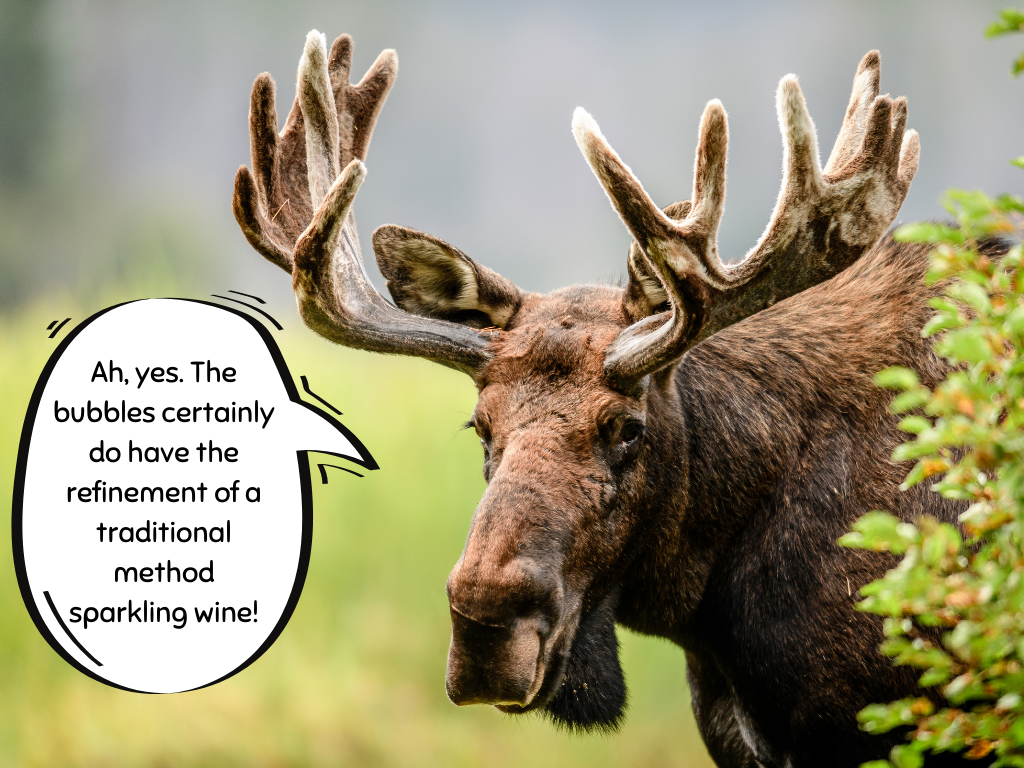
When you assess each wine, make a note of whether or not you feel the bubbles are lower or higher in pressure in a particular wine (are slower, lazier in ascent versus more explosive, urgent). This might be difficult to do when you’re only sampling a single sparkling wine but you’ll have THREE, so observe how the bubbles behave comparatively.
Remember, mousse alone won’t help you identify the wine, especially when you’re comparing traditional methods wines, which are virtually indistinguishable in bubbly characteristics. However, there are lots of sparkling wine styles that are made with lower pressure, which will be an important clue that’ll either support or debunk your ID.
Tip 11: Does the color confirm your ID?
You’ll probably assess the color first but once you’ve taken your aroma and flavor notes, and have even arrived at an identification for the sparkling wine, take another look at the color and ask yourself if it confirms your assessment.
A pale color typically indicates a younger wine and/or a cool climate. A richer, deeper color points towards the use of oak aging, bottle age, and/or a warmer climate. Use these clues to your advantage!
Pro Tip: Circling back around and asking yourself this question forces you to view your identified wine through the lens of your color observations (or even ALL your other observations). Then, if something doesn’t fit, you’ll realize it before you submit your final tasting notes!
Tip 12: Put a bottle on ice
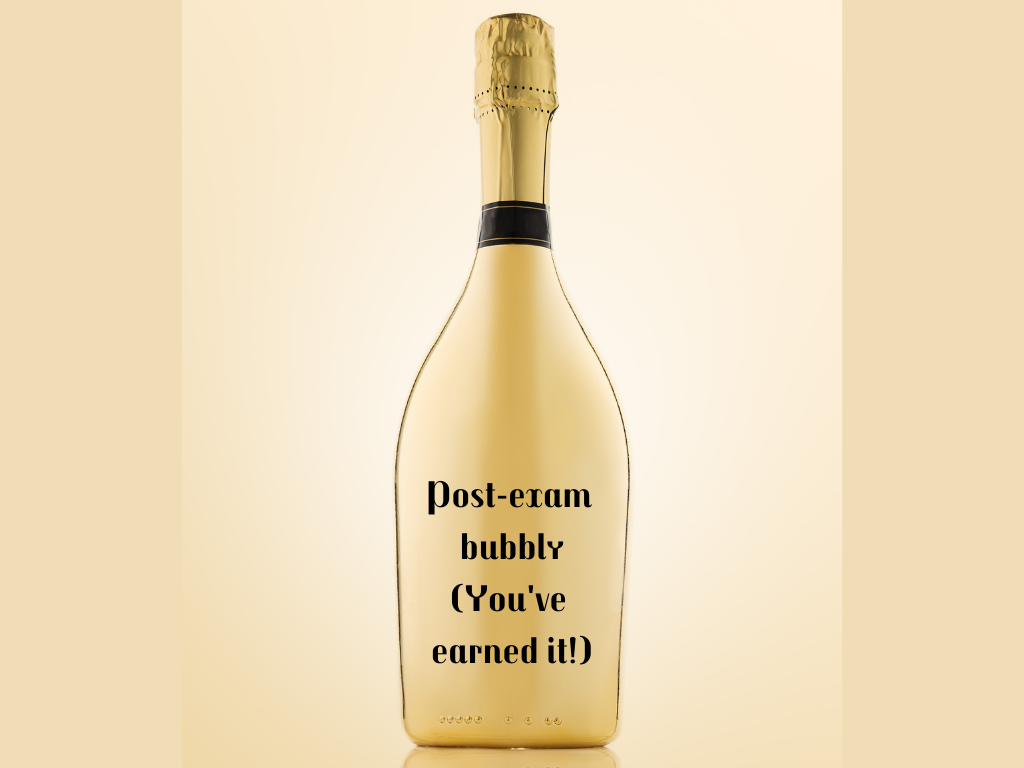
You may wish to never see another bottle of sparkling wine after finishing your WSET Diploma on Sparkling Wines (D4) but, trust me, that feeling has a lifespan of minutes. So make sure you load up the fridge with a bottle of your best bubbles so that you can toast yourself and the incredible effort you’ve made.
You’ve earned it!
A final word on the WSET Diploma 4 on Sparkling Wine
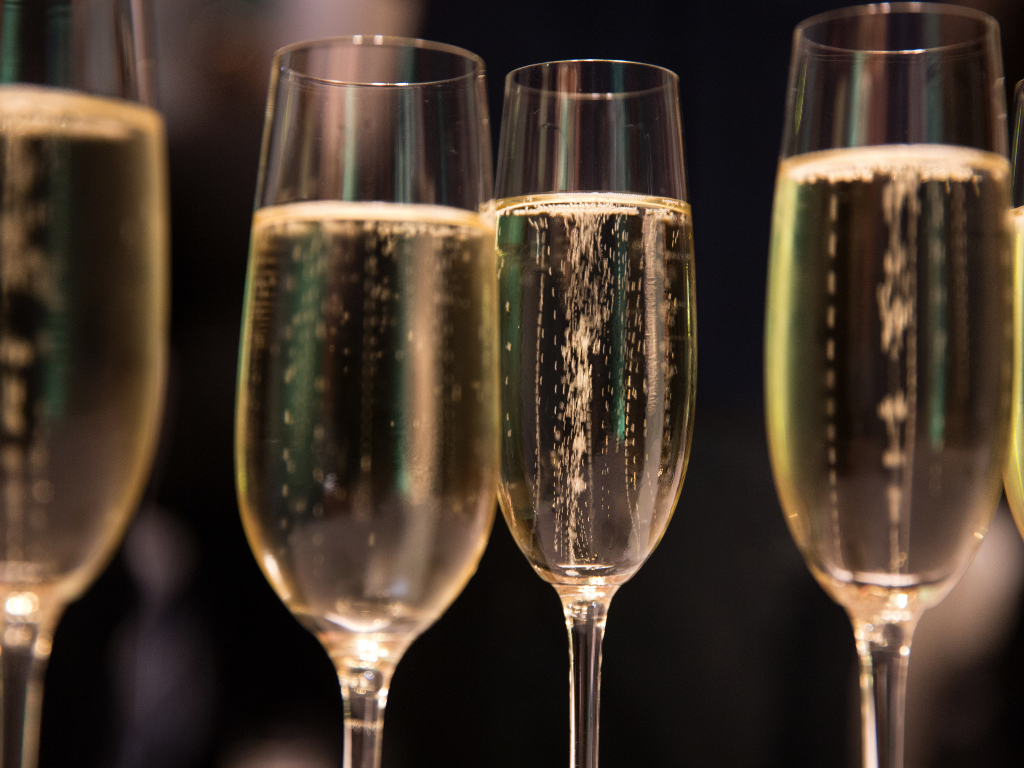
If you give yourself time and dedicate yourself to daily study, with plenty of practice, there’s no reason that that bottle of post-exam sparkling wine should remain unopened. Just remember that there’s no shortcut around having to learn, understand, and memorize all the WSET 4 D4 information so the earlier you start and the more efficiently you study, the better.
And remember: Brainscape’s collection of WSET Diploma D4 Sparkling Wine flashcards makes the theory portion easy for you because it:
- Has already broken down the entire WSET Diploma 4 (D4) curriculum into the most essential facts you need to know;
- Organizes all of this information into 13 neatly labeled decks, which you can study independently or in one great mix;
- Uses spaced repetition and other proven cognitive science principles (like metacognition and active recall) to help you learn more efficiently; and
- Is an app on your phone, device, and laptop, which you can take with you any and everywhere you go, sneaking in quick study sessions in any free time you may have.
So now there’s nothing left to say except that the team here at Brainscape wishes you all the best with your studies and may you use these tools and advice to rise to your challenge!
And when you’re ready to move onto your next module, know that Brainscape has got your back with these awesome resources:
- Certified Flashcards: WSET Diploma D1 on Wine Productions
- Study Guide: How to pass the WSET 4 D1 exam on Wine Production
- Certified Flashcards: WSET Diploma D2 on the Business of Wine
- Study Guide: How to pass the WSET Diploma D2 exam on the Business of Wine
- Certified Flashcards: WSET Diploma D3 on Wines of the World
- Study Guide: How to pass the WSET Diploma D3 exam on the Wines of the World
- Certified Flashcards: WSET Diploma D5 on Fortified Wines
- Study Guide: How to pass the WSET Diploma D5 exam on Fortified Wines
For a fun introductory video on Champagne, check out our interview with Chelsie Petras of the 'Babes + Booze' podcast.
*Disclaimer: Brainscape has worked with top wine experts to supplement the official publications and preparation offered by WSET. We are not officially endorsed by or connected to WSET itself.
